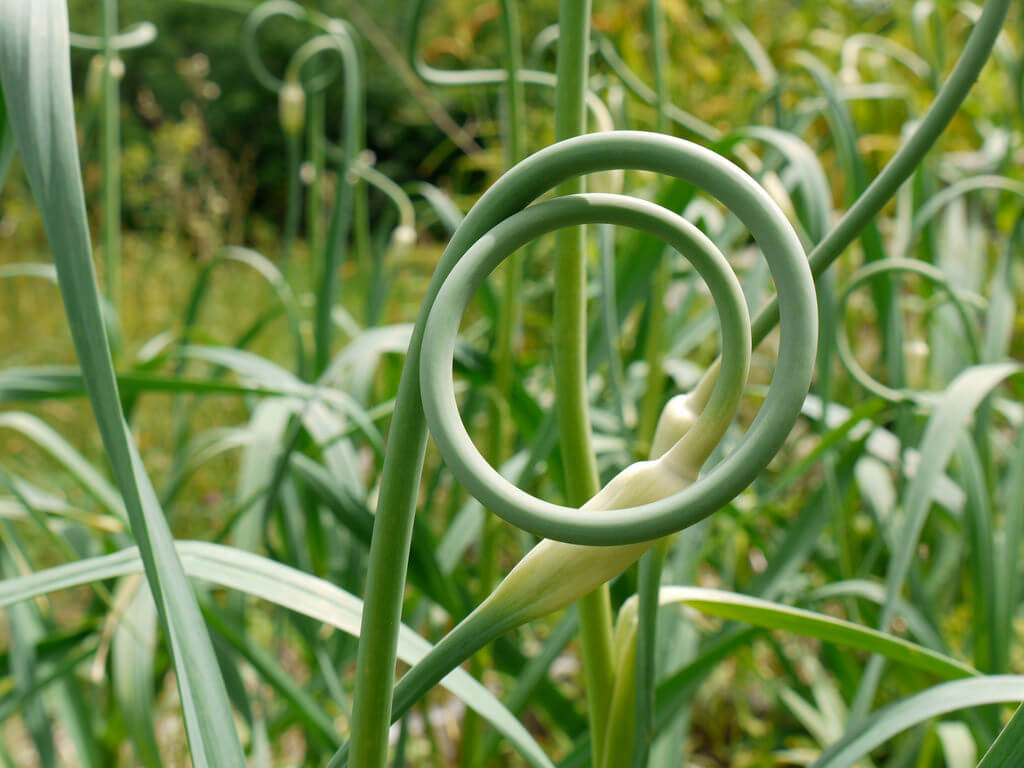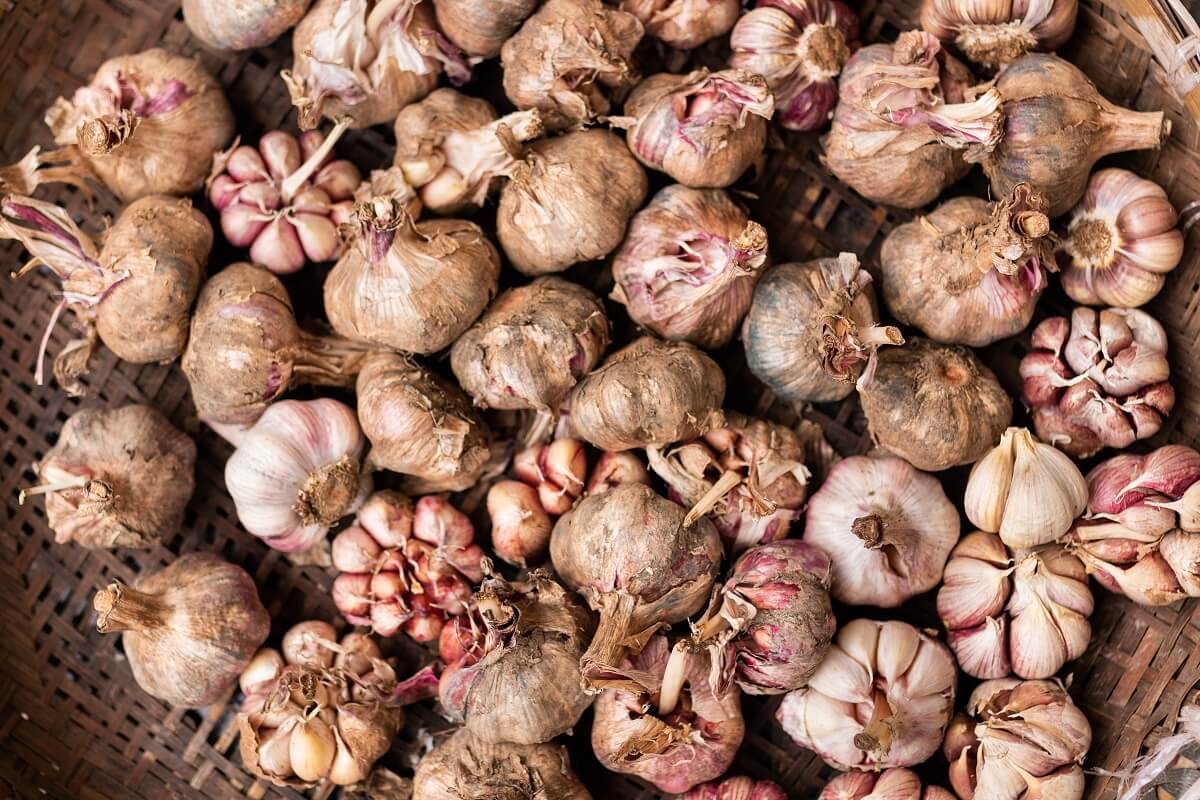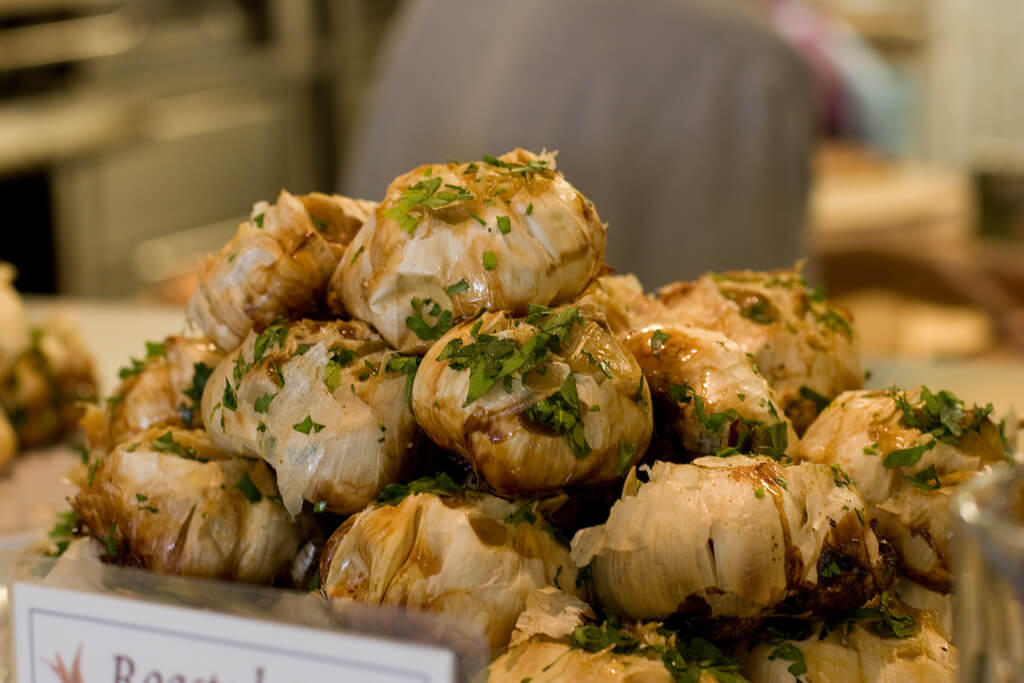A staple in homestead gardens, garlic is easy to plant, easy to maintain, easy to harvest, and transports and stores well. With a little effort, homesteaders can grow garlic for home consumption and a supplemental cash crop.
Garlic: fresh, pickled, dehydrated, packed in olive oil, or used to season savory edibles, is always a big seller at local fresh markets.
The six best ways to store garlic include
- Stocking garlic long term in a cool, dark place
- Freezing garlic
- Preserving garlic in olive oil
- Roasting garlic in the oven
- Dehydrating garlic
- Pickling garlic
Read on to learn a bit more about garlic and how to store it in a variety of ways to get the most out of your crop or farmer’s market purchase.
Long-Term Garlic Storage
In order to get the most return out of your harvest, store garlic bulbs in a cool, dry place out of direct sunlight. Garlic stores best in a dark space with good air circulation at about 60 degrees Fahrenheit. Hang garlic bulbs in a mesh bag or store them in a loosely-woven basket.
Harvest or purchase garlic bulbs that are firm and fresh. Avoid bulbs that have sprouted or with cuts, bruising, or soft spots. In addition to storing garlic in a dark, cool location, you can also freeze, dehydrate, pickle, roast, or preserve garlic in olive oil.
Freeze Garlic To Preserve Freshness And Flavor
One of the easiest ways to store garlic for home consumption is in the freezer. Garlic does not have to be blanched before freezing. Spread out peeled garlic cloves on a cookie or baking tray and freeze for 20 to 30 minutes.
Transfer the frozen cloves to airtight freezer containers, or store in freezer-proof storage bags. Return the packaged cloves to the freezer and the garlic cloves will stay fresh and flavorful for up to 12 months. When stored this way, it is easy to grab a clove or two as needed for seasoning soups, sauces, and salsa just as you would use fresh garlic.
Preserve Garlic In Olive Oil
To store garlic in olive oil, peel individual cloves and submerge them in oil in glass containers with airtight lids. This is a great way to store garlic. If you want a mild flavor, use a teaspoon or more of the oil for cooking or salad dressing. If you seek a stronger garlic flavor, remove a clove or two from the oil, and their flavor will be as aromatic and flavorful as if it was fresh from the garden.
Garlic may also be finely chopped or pureed in a blender and mixed with one-part garlic to two-parts extra virgin olive oil. Store garlic preserved in olive oil away from sunlight in a cool place, or store it in the refrigerator.
Roast Garlic In The Oven
If you’re blessed with an extra crop of garlic, but lack time to pickle or can it, roasting and freezing garlic bulbs is the fastest way to process the harvest. Roasted garlic presents a more mellow flavor than fresh garlic. Try it as a tasty spread on bruschetta, toast, sandwiches, appetizers, baked potato, or added to your favorite pizza topping.
Roast garlic in a glass casserole dish coated with extra virgin olive oil. There is no need to peel the bulb. Bake bulbs at 350 degrees Fahrenheit for 35 to 40 minutes, or until they are soft and golden brown. Remove the roasted garlic from the oven, and allow it to cool. Once cool, cut the top off the bulb and gently pinch to release the now soft cloves.
Store roasted cloves in small, airtight freezer containers. Because of the high olive oil content, it’s easy to scoop out the frozen roasted garlic as needed.
Dehydrate Garlic
Dehydrating garlic is easy. Thinly slice peeled garlic and place the slices on a dehydrator tray. Set the dehydrator on low and let the garlic dehydrate for 10 to 12 hours.
Garlic can also be dehydrated in the oven. Place garlic slices on a baking tray or cooking sheet and allow them to dry in a warm oven.
Set the temperature to 125 degrees Fahrenheit. Bake for 1 or 2 hours or until crisp and dry. Dehydrated garlic keeps up to 12 months when stored in an airtight container.
Pickle Garlic In Vinegar
Garlic is an integral ingredient in many pickle, chutney, flavored vinegar, sauce, or salsa recipes. It’s fun to experiment with fresh herbs and garlic to create an enhanced version of your family’s favorite dish. Here’s one of my favorite variations for pickled garlic.
Sweet And Spicy Pickled Garlic
Ingredients
- 3 cups garlic cloves, peeled
- 2 quarts water
- 3 cups white vinegar
- 1 cups granulated white sugar
- 1/2 cup honey
- 2 teaspoons kosher salt
- 1 teaspoon whole cloves
- 1 teaspoon whole black peppercorns
- 1 teaspoon fennel seeds
- 1 teaspoon mustard seeds
- 1 teaspoon dried chili pepper flakes
- 1/2 teaspoon ground cardamom
Directions
- In a 3-quart saucepan, bring water to boil.
- Add garlic cloves, reduce heat and simmer for 3 to 5 minutes or until cloves are slightly tender.
- Remove from heat, drain, and pack garlic into hot half-pint canning jars, filling to within a one-half inch from the top.
- In a saucepan, combine honey, vinegar, salt, sugar, and spices.
- Bring mixture to a boil, stirring frequently. Reduce heat and simmer for 5 minutes.
- Ladle hot mixture over garlic, allowing a one-half inch of head space.
- Wipe rims with a soft cloth dipped in boiling water.
- Center the lids and screw on bands until snug.
Types Of Garlic
A cool season crop, garlic is a member of the Alliaceae (lily) family which is the same family as leeks, shallots, and onions. A hardy perennial that will winter over well, garlic produces an abundant crop each season. However, it is most often cultivated as an annual because it is normally harvested during the first season of growth.
There are two types of garlic: hardneck and softneck. Hardneck varieties tend to bolt in late spring, developing tall, flowering stalks also known as scapes. Tiny aerial cloves, known as bulbils, appear at the tip of the scapes.

Hardneck garlic is winter hardy and tends to produce larger cloves, but it does not store dry as well as softneck varieties. Hardneck garlic is, however, a great choice if you plan to sell your crop at the market or can, pickle, freeze, or dehydrate the harvest.
Choose softneck varieties if you plan to craft garlic braids and wreaths, or hang your garlic in dry storage. Hardneck garlic, with a stiff central stalk, will break and shatter the bulb if you attempt to braid or twist it.
History Of Garlic
Native to Central Asia, garlic was once considered a sacred plant and treasured for its impressive medical properties.
Today, the pungent plant is valued more for its zesty flavoring properties and is widely used in a diverse array of dishes in cultures worldwide. Garlic is still highly prized for its medicinal qualities including antioxidant and antibiotic effects. It also helps reduce blood pressure and cholesterol levels.

In China, many people consume as many as 12 cloves of garlic a day to maintain good health. Bangladesh, China, and India are the world’s largest producers of garlic. China produces more than two-thirds of the world’s garlic with more than 467 million pounds exported in 2016.
Related Post: Foraging for Field Garlic
The Biggest Importer Of Garlic
Although introduced in the early 1700s, garlic did not gain popularity in the United States until the 1920s. Today, U.S. annual consumption per capita per year, is approximately 2 pounds. Since 1998, the U.S. is the world’s leading import market for fresh garlic. We love the stuff! In 2017, the U.S. imported 198 million pounds of fresh garlic and 141 million pounds of dried garlic valued at over 305 million dollars.
In the United States, we also grow a lot of garlic to meet demand. U.S. production in 2017 exceeded 510 million pounds. California, Nevada, and Oregon are the largest growers of garlic in the U.S.
Nutritional Notes
Garlic is high in manganese, vitamin B6, and vitamin C, and provides healthy amounts of copper, calcium, phosphorous, potassium, iron and vitamin B1 with only four calories per clove.
References:
- Vegetables: Growing Garlic in Home Gardens, Washington State University Extension
- Pickling, National Center for Home Food Preservation
- Garlic Profile, Agricultural Marketing Research Center
- Garlic, WebMD
- Herb Gardening, University of Illinois Extension
- Garlic Bacon Sautéed Green Beans with Roasted Mushrooms, Good Life Eats
- Growing Garlic, Johnny’s Seeds












































Leave a Reply